Aliments and medicinal plants which favours the enjoyment of happiness (3)
by ayurveda teacher Andrei Gămulea
Read here the second part of this article:
Aliments and medicinal plants which favours the enjoyment of happiness (2)
HARITAKI
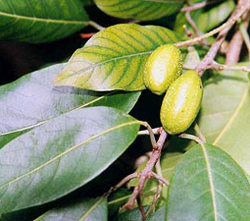 The Haritaki fruit (Terminalia chebula), is not at random known and appreciated in the Tibetan tradition under the name “the king of natural remedies”. On the other hand, in the traditional works of Ayurveda, the Haritaki fruits are frequently enumerated as basic ingredients in the most numerous revitalizing therapeutic formulas, thanks to its multiple healing virtues. The ayurvedic tradition underlines the fact that the Haritaki fruits present a remarkable property: from the 6 known elementary tastes (sweet, salty, sour, pungent, bitter and astringent) and which through combination, in different proportions, give birth to the entire diversity of tastes existing in the nature, the Haritaki fruits present five of the 6 tastes(sweet, sour, pungent, bitter and astringent).This specific combination determines among others the regenerating and revitalizing properties of the Haritaki fruits. Recent scientific researches have shown that the haritaki fruits have important antioxidant properties that contribute in the case of their constant use, to the bettering of the living tissues from the human body. The Haritaki fruits have a rich content of vitamin C, that plays an important part in the improving of the psycho-mental and cognitive functions and contribute at the same time to a better adaptation of the organism to the factors generating stress.
The Haritaki fruit (Terminalia chebula), is not at random known and appreciated in the Tibetan tradition under the name “the king of natural remedies”. On the other hand, in the traditional works of Ayurveda, the Haritaki fruits are frequently enumerated as basic ingredients in the most numerous revitalizing therapeutic formulas, thanks to its multiple healing virtues. The ayurvedic tradition underlines the fact that the Haritaki fruits present a remarkable property: from the 6 known elementary tastes (sweet, salty, sour, pungent, bitter and astringent) and which through combination, in different proportions, give birth to the entire diversity of tastes existing in the nature, the Haritaki fruits present five of the 6 tastes(sweet, sour, pungent, bitter and astringent).This specific combination determines among others the regenerating and revitalizing properties of the Haritaki fruits. Recent scientific researches have shown that the haritaki fruits have important antioxidant properties that contribute in the case of their constant use, to the bettering of the living tissues from the human body. The Haritaki fruits have a rich content of vitamin C, that plays an important part in the improving of the psycho-mental and cognitive functions and contribute at the same time to a better adaptation of the organism to the factors generating stress.
BILVA
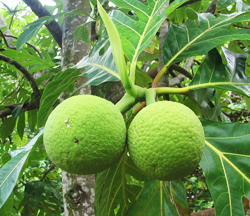 In the oriental spiritual tradition the tree Bilva (Aegle marmelors) represents a living symbol of the spiritual life, being known in India as “SHIVA’s sacred tree”. In Ayurveda, the benefic effects of the Bilva fruits are compared to the benefic virtues of the heavenly ambrosia (AMRITA).Not at random, the Bilva tree in present in India in most of the temples’ gardens consecrated to Shiva and it’s almost permanent in the natural ambiance in which different ritual celebrations of India’s spiritual tradition take place. The mentions referring to the use in therapeutic purpose of the Bilva fruits appear from the ancient Vedic writings and continue in almost all the traditional works of Ayurveda. The famous ayurvedic work “Charaka Samhita” frequently refers to the rejuvenating and revitalizing properties of these fruits, of whose aspect is impressive, through their round shape, of whose diameter often overruns 10cm.The modern scientific researches have shown that the Bilva fruits have a rich content of alpha-tocoferol, the most active compound from the vitamin E class, of whose antioxidant action makes possible the slowing of aging processes. Besides, if they are consumed frequently, the Bilva fruits can help, through the form of the natural vitamin E that they contain, the ones who live in polluted areas and those who, even if they don’t smoke, come sometimes to expose themselves accidentally to the harm of the cigarette smoke that is sometimes present in public places.
In the oriental spiritual tradition the tree Bilva (Aegle marmelors) represents a living symbol of the spiritual life, being known in India as “SHIVA’s sacred tree”. In Ayurveda, the benefic effects of the Bilva fruits are compared to the benefic virtues of the heavenly ambrosia (AMRITA).Not at random, the Bilva tree in present in India in most of the temples’ gardens consecrated to Shiva and it’s almost permanent in the natural ambiance in which different ritual celebrations of India’s spiritual tradition take place. The mentions referring to the use in therapeutic purpose of the Bilva fruits appear from the ancient Vedic writings and continue in almost all the traditional works of Ayurveda. The famous ayurvedic work “Charaka Samhita” frequently refers to the rejuvenating and revitalizing properties of these fruits, of whose aspect is impressive, through their round shape, of whose diameter often overruns 10cm.The modern scientific researches have shown that the Bilva fruits have a rich content of alpha-tocoferol, the most active compound from the vitamin E class, of whose antioxidant action makes possible the slowing of aging processes. Besides, if they are consumed frequently, the Bilva fruits can help, through the form of the natural vitamin E that they contain, the ones who live in polluted areas and those who, even if they don’t smoke, come sometimes to expose themselves accidentally to the harm of the cigarette smoke that is sometimes present in public places.
AMALAKI
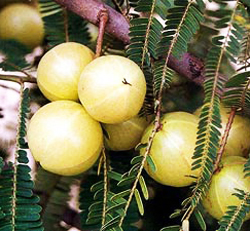 Well-known in the tradition of the millenary system Ayurveda, the Amalaki fruits (Emblica officinalis) represent an important and rich natural source of vitamin C: between 600mg and 1800mg per 100g of Amalaki fruits. Be they used fresh, or as dried powder, the Amalaki fruits generate a powerful strengthening effect. The vitamin C that they contain rapidly generates stimulation effects of the cerebral activity. The big quantities of vitamin C contained in the Amalaki fruits are of great help to forestall the drawbacks that usually derive from the stressful situations, when the consumption of noradrenalin and adrenaline is much increased. Therefore, the Amalaki fruits represent an important natural way to fight against the stress and to improve the psychic and intellectual functions. Not at random, these fruits with a strong and pleasant sourish taste, which after they are well chewed, a surprising, sweet, extremely pleasant, intense and refined taste appears, are used in the traditional ayurvedic formulas for rejuvenation and regeneration.
Well-known in the tradition of the millenary system Ayurveda, the Amalaki fruits (Emblica officinalis) represent an important and rich natural source of vitamin C: between 600mg and 1800mg per 100g of Amalaki fruits. Be they used fresh, or as dried powder, the Amalaki fruits generate a powerful strengthening effect. The vitamin C that they contain rapidly generates stimulation effects of the cerebral activity. The big quantities of vitamin C contained in the Amalaki fruits are of great help to forestall the drawbacks that usually derive from the stressful situations, when the consumption of noradrenalin and adrenaline is much increased. Therefore, the Amalaki fruits represent an important natural way to fight against the stress and to improve the psychic and intellectual functions. Not at random, these fruits with a strong and pleasant sourish taste, which after they are well chewed, a surprising, sweet, extremely pleasant, intense and refined taste appears, are used in the traditional ayurvedic formulas for rejuvenation and regeneration.
ASHVAGANDHA
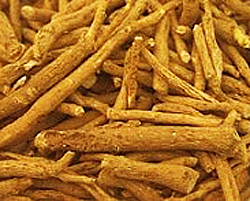 Known and appreciated as a genuine “Indian ginseng”, the Ashwagandha root (Withania somnifera) represents a valuable general revigourant of the organism. In the frame opf the traditional system of Ayurveda, the Ashwangadha root is quoted among the most important remedies that allow the setting in of a profound relation state and that at the same time allows shortly the recovering of the emotional balance. Biochemical researches and clinical studies recently made show that from a statistic point of view, the use in therapeutic purpose of the Ashwagandha root leads to a considerable decrease of the cortisone and of catecholamine through the urinary secretion, or it is known the fact that their excess represents one of the causes of stress states. The Ashwaganda root contains the withaferine –A, alkaloid that stimulates the activity of the acetylcholine at cerebral level. Therefore, the herb contributes to the bettering of the memory performances and to the optimization of the cognitive and learning processes. Also, the glyco-withanoloids contained in the herb contribute to the decrease of the states of nervousness, of the tension, anxiety and of depressive states. The Ashwagandha root has a slight pleasant sweet taste, reason for which it is possible to take it constantly, for long periods of time. Used in such a way, it contributes efficiently to the recovery of the emotional welfare and the amplification of mental capacities. Besides, the Ashwagandha root confers a more and more lasting independence in the unaltered maintaining of the psychic positive and sthenic states.
Known and appreciated as a genuine “Indian ginseng”, the Ashwagandha root (Withania somnifera) represents a valuable general revigourant of the organism. In the frame opf the traditional system of Ayurveda, the Ashwangadha root is quoted among the most important remedies that allow the setting in of a profound relation state and that at the same time allows shortly the recovering of the emotional balance. Biochemical researches and clinical studies recently made show that from a statistic point of view, the use in therapeutic purpose of the Ashwagandha root leads to a considerable decrease of the cortisone and of catecholamine through the urinary secretion, or it is known the fact that their excess represents one of the causes of stress states. The Ashwaganda root contains the withaferine –A, alkaloid that stimulates the activity of the acetylcholine at cerebral level. Therefore, the herb contributes to the bettering of the memory performances and to the optimization of the cognitive and learning processes. Also, the glyco-withanoloids contained in the herb contribute to the decrease of the states of nervousness, of the tension, anxiety and of depressive states. The Ashwagandha root has a slight pleasant sweet taste, reason for which it is possible to take it constantly, for long periods of time. Used in such a way, it contributes efficiently to the recovery of the emotional welfare and the amplification of mental capacities. Besides, the Ashwagandha root confers a more and more lasting independence in the unaltered maintaining of the psychic positive and sthenic states.
KAMALA
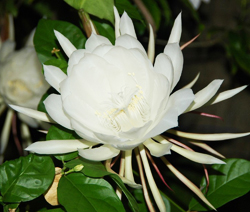 The lotus flowers, (Nelumbo nucifera) play an important part in the frame of different healing traditions of the Orient. In Ayurveda the lotus flowers (Kamala) are appreciated as being the most efficient sedative and refreshing, being therefore used to reduce the inflammatory states and at the same time for the elimination of the straining states, tension or stress. In the oriental spiritual tradition the lotus flowers (Kamala) represent a sacred symbol of deep meditative states that can be reached after the consequent practice of the Yoga techniques. In the frame of the millenary Yoga system, the lotus flowers (Kamala) are directly associated to the states of interiorization and deep yogic meditation. Usually taken under the tongue, as dried powder, the lotus flowers (Kamala) can quickly generate a profound state of mind calmness, of interiorization, serenity, inner peace and therefore it settles in rapidly a sublime state of happiness without object (Ananda). The lotus flowers (Kamala) contain lotusine and nucifere, compounds that determine a specific effect of cerebral stimulation and which generate a general state of extremely pleasant relaxation that is felt almost in the whole body. The pleasant state that is generated by the use of the lotus flowers (Kamala) is often appreciated as being the state of “ravishing joy”.
The lotus flowers, (Nelumbo nucifera) play an important part in the frame of different healing traditions of the Orient. In Ayurveda the lotus flowers (Kamala) are appreciated as being the most efficient sedative and refreshing, being therefore used to reduce the inflammatory states and at the same time for the elimination of the straining states, tension or stress. In the oriental spiritual tradition the lotus flowers (Kamala) represent a sacred symbol of deep meditative states that can be reached after the consequent practice of the Yoga techniques. In the frame of the millenary Yoga system, the lotus flowers (Kamala) are directly associated to the states of interiorization and deep yogic meditation. Usually taken under the tongue, as dried powder, the lotus flowers (Kamala) can quickly generate a profound state of mind calmness, of interiorization, serenity, inner peace and therefore it settles in rapidly a sublime state of happiness without object (Ananda). The lotus flowers (Kamala) contain lotusine and nucifere, compounds that determine a specific effect of cerebral stimulation and which generate a general state of extremely pleasant relaxation that is felt almost in the whole body. The pleasant state that is generated by the use of the lotus flowers (Kamala) is often appreciated as being the state of “ravishing joy”.
BRAHMI
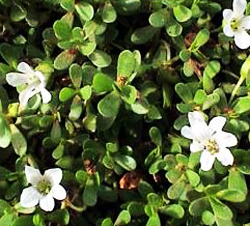 Well-known especially in the millenary ayurvedic tradition, the Indian herb Brahmi (Bacopa monnieri) has become nowadays well-known in the entire world, for its multiple benefic effects that its use has on the cerebral functions. The modern studies have shown that the Indian herb Brahmi contributes to the increase of the mental capacity of concentration, to the amplification of the focusing power of attention and to the bettering of the memory performances. The herb contains bacozides and tritepenoid saponines, both being responsible for the bettering of the nervous transmission. In particular, the bacozides, that are the main ingredient contained in the herb, improve the synaptic activity, that leads to the general effect of increasing the mental power. In the ayurvedic tradition, Brahmi is described as being one of the most important herbs with invigorating cerebral effect. Its constant use as dry powder, under the tongue, can determine gradually the appearance of a general effect of improving the intelligence functions that translates especially into the improving effects of the mental functions of planning and problems solving, as well as into the activation of all the cerebral processes that need a rapid processing of the information.
Well-known especially in the millenary ayurvedic tradition, the Indian herb Brahmi (Bacopa monnieri) has become nowadays well-known in the entire world, for its multiple benefic effects that its use has on the cerebral functions. The modern studies have shown that the Indian herb Brahmi contributes to the increase of the mental capacity of concentration, to the amplification of the focusing power of attention and to the bettering of the memory performances. The herb contains bacozides and tritepenoid saponines, both being responsible for the bettering of the nervous transmission. In particular, the bacozides, that are the main ingredient contained in the herb, improve the synaptic activity, that leads to the general effect of increasing the mental power. In the ayurvedic tradition, Brahmi is described as being one of the most important herbs with invigorating cerebral effect. Its constant use as dry powder, under the tongue, can determine gradually the appearance of a general effect of improving the intelligence functions that translates especially into the improving effects of the mental functions of planning and problems solving, as well as into the activation of all the cerebral processes that need a rapid processing of the information.
Gingko
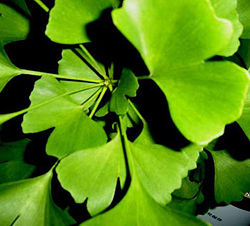 The Gingko tree (Gingko biloba) comes from China, but currently it is cultivated almost in the whole world. Even if it has a slow growth, it is likely to reach up to 35 meters high. Its spread is owed especially to the therapeutic virtues of its leaves, on which it is known that they had been used in the traditional Chinese medicine for 3000 years, due to their rejuvenating effects. Not at random, in the tradition of the Chinese medicine, the Gingko tree is known under the symbolic name of “The fountain of the youth and of vitality”. The modern scientific researches have shown that the Gingko leaves contain triptofane, essential ingredient for the maintaining of the psycho-emotional balance and of the general welfare state. The Gingko leaves also contain a large scale of flavonoids of whose antioxidant action is responsible for the maintaining of the general wellbeing. Also, through the bioflavonoids that they contain, the Gingko leaves contribute to the bettering of the cerebral and peripherical circulation. Thanks to their specific content, the Gingko leaves are at the same time useful to the improving of the memory functions. Their use as powder, under the tongue, can help us to rapidly regain the psycho-mental balance and it allows us at the same time to awake and increase the state of optimism state.
The Gingko tree (Gingko biloba) comes from China, but currently it is cultivated almost in the whole world. Even if it has a slow growth, it is likely to reach up to 35 meters high. Its spread is owed especially to the therapeutic virtues of its leaves, on which it is known that they had been used in the traditional Chinese medicine for 3000 years, due to their rejuvenating effects. Not at random, in the tradition of the Chinese medicine, the Gingko tree is known under the symbolic name of “The fountain of the youth and of vitality”. The modern scientific researches have shown that the Gingko leaves contain triptofane, essential ingredient for the maintaining of the psycho-emotional balance and of the general welfare state. The Gingko leaves also contain a large scale of flavonoids of whose antioxidant action is responsible for the maintaining of the general wellbeing. Also, through the bioflavonoids that they contain, the Gingko leaves contribute to the bettering of the cerebral and peripherical circulation. Thanks to their specific content, the Gingko leaves are at the same time useful to the improving of the memory functions. Their use as powder, under the tongue, can help us to rapidly regain the psycho-mental balance and it allows us at the same time to awake and increase the state of optimism state.
Passiflora
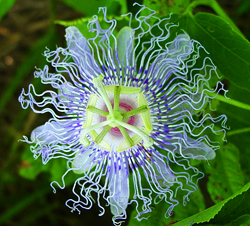 The name of Passiflora comes from the Italian expression “fior de la passione”. Impressive and triumphant especially through the extraordinary beautiful shape of its flowers, Passiflora (Passiflora incarnata) is a valuable remedy that allows the elimination of the nervous tension states, anxiety or depression. Passiflora contains a series of flavonoids, which determine the relaxing and deeply calming action that the herb has on the nervous system. The clinical studies and the modern scientific researches that have been conducted on the content of this plant have shown that the Passiflora has as main ingredient a monoflavonoid, the chrysene, that acts particularly on the brain, so that the leaves and the flowers of this herb prove to be extremely efficient on the elimination of the fear without object or of panic states, as well as in the elimination of the drawbacks and of the disorders that result from the deep states of emotional stress. The use of Passiflora dry powder settles in the being a profound state of peace and calmness.
The name of Passiflora comes from the Italian expression “fior de la passione”. Impressive and triumphant especially through the extraordinary beautiful shape of its flowers, Passiflora (Passiflora incarnata) is a valuable remedy that allows the elimination of the nervous tension states, anxiety or depression. Passiflora contains a series of flavonoids, which determine the relaxing and deeply calming action that the herb has on the nervous system. The clinical studies and the modern scientific researches that have been conducted on the content of this plant have shown that the Passiflora has as main ingredient a monoflavonoid, the chrysene, that acts particularly on the brain, so that the leaves and the flowers of this herb prove to be extremely efficient on the elimination of the fear without object or of panic states, as well as in the elimination of the drawbacks and of the disorders that result from the deep states of emotional stress. The use of Passiflora dry powder settles in the being a profound state of peace and calmness.
The melissa
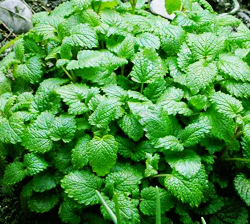 Having an extremely pleasant flavor, the Melissa (Melissa officinalis) is one of the herbs of whose vivid presence in the gardens of herbs’ lovers is almost permanent. Even a mere touch of its leaves, lets an extremely pleasant and calming olfactory trace. The Melissa leaves contain geraniol, substance of whose antioxidant effects have been certified by numerous modern scientific studies. Besides, both the geraniol, and the rozmarinic acid and the flavonoids contained in the Melissa leaves determine the existence of a large scale of benefic effects that the herb exerts in the psycho-mental sphere. Discorides enumerates the Melissa among the most efficient healing herbs that were used by the ancient Greeks for the treatment of nervous disorders. The use of dry powder of the Melissa leaves improves the performances of the memory, stabilizes the emotional fluctuations, reduces and eliminates the states of nervousness and psychic tension and it’s an excellent sedative. In the 17th century, John Evelyn, a famous naturalist of those times, appreciated the Melissa for its strong energizing action that it determines especially at the psychic and mental level. Used be it fresh or dried, the Melissa can make rapidly disappear the states of melancholy, the ailing emotivity and the depression, replacing them quickly with a sthenic, full of confidence and joy psychic state.
Having an extremely pleasant flavor, the Melissa (Melissa officinalis) is one of the herbs of whose vivid presence in the gardens of herbs’ lovers is almost permanent. Even a mere touch of its leaves, lets an extremely pleasant and calming olfactory trace. The Melissa leaves contain geraniol, substance of whose antioxidant effects have been certified by numerous modern scientific studies. Besides, both the geraniol, and the rozmarinic acid and the flavonoids contained in the Melissa leaves determine the existence of a large scale of benefic effects that the herb exerts in the psycho-mental sphere. Discorides enumerates the Melissa among the most efficient healing herbs that were used by the ancient Greeks for the treatment of nervous disorders. The use of dry powder of the Melissa leaves improves the performances of the memory, stabilizes the emotional fluctuations, reduces and eliminates the states of nervousness and psychic tension and it’s an excellent sedative. In the 17th century, John Evelyn, a famous naturalist of those times, appreciated the Melissa for its strong energizing action that it determines especially at the psychic and mental level. Used be it fresh or dried, the Melissa can make rapidly disappear the states of melancholy, the ailing emotivity and the depression, replacing them quickly with a sthenic, full of confidence and joy psychic state.
The hardhay
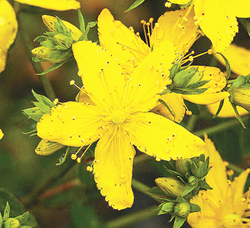 The hardhay (Hypericum perforatum) has become famous, especially in the West, thanks to antidepressive virtues. Recent statistic studies show that that there are currently millions of Americans that use the natural remedies in which the hardhay is the main ingredient. The main purpose of the use of natural remedies based on hardhay is especially the improving of the psychic and emotional states and the elimination of the tendencies to depressive states that occur especially among those who live in the great urban throngs. Most of the persons that use the natural remedies based on hardhay often do it in preventive purpose, especially because the hardhay confers them an excellent psychic wellbeing. The modern scientific studies have proved that the hardhay contains at least 10 compounds that are responsible for the benefic effects on the nervous system. For example, the hyperforine contained in the hardhay determines especially the balancing emotional effects. The hardhay also contains the hypericine and flavonoids, all these contributing to the constant maintaining of a positive psycho-mental state, that allows to overrun well the stressing situations, the nervousness, the tension and the anxiety. Used constantly as dry powder, the hardhay can make possible to maintain a predominant state of calmness and good mood that allows us to fully enjoy what is wonderful and happy in life.
The hardhay (Hypericum perforatum) has become famous, especially in the West, thanks to antidepressive virtues. Recent statistic studies show that that there are currently millions of Americans that use the natural remedies in which the hardhay is the main ingredient. The main purpose of the use of natural remedies based on hardhay is especially the improving of the psychic and emotional states and the elimination of the tendencies to depressive states that occur especially among those who live in the great urban throngs. Most of the persons that use the natural remedies based on hardhay often do it in preventive purpose, especially because the hardhay confers them an excellent psychic wellbeing. The modern scientific studies have proved that the hardhay contains at least 10 compounds that are responsible for the benefic effects on the nervous system. For example, the hyperforine contained in the hardhay determines especially the balancing emotional effects. The hardhay also contains the hypericine and flavonoids, all these contributing to the constant maintaining of a positive psycho-mental state, that allows to overrun well the stressing situations, the nervousness, the tension and the anxiety. Used constantly as dry powder, the hardhay can make possible to maintain a predominant state of calmness and good mood that allows us to fully enjoy what is wonderful and happy in life.
The echinacea
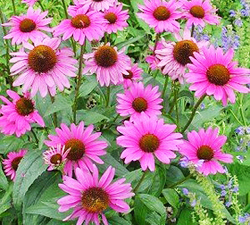 Native from North America, the Echinacea (Echinacea purpurea) has become to be known in almost the entire world for its imunostimulent properties. The modern scientific researches have shown that the herb contains cicoric acid, a compound from the group of the polifenolies, on which it has been established that it increases considerably the efficiency of the immunitary system. The cicoric acid intensifies the interferon and immunoglobine production, contributing through these to the bettering of the immunity. Besides, the cicoric acid presents also antioxidant properties. Therefore, the constant use for some periods of time of the remedies that contain Echinacea, leads to a rapid increase of the natural capacity of the organism’s defense against the bacterial or viral infections. And besides this, the herb fully contributes to the decrease and then to the elimination of tiredness states, of emotional disorders and of depressive states. The general stimulating effect of Echinacea makes it possible to appear shortly a sthenic state of good humourness that allows the fast redefinition of the inner motivation to be active and confident in what it is good and beautiful.
Native from North America, the Echinacea (Echinacea purpurea) has become to be known in almost the entire world for its imunostimulent properties. The modern scientific researches have shown that the herb contains cicoric acid, a compound from the group of the polifenolies, on which it has been established that it increases considerably the efficiency of the immunitary system. The cicoric acid intensifies the interferon and immunoglobine production, contributing through these to the bettering of the immunity. Besides, the cicoric acid presents also antioxidant properties. Therefore, the constant use for some periods of time of the remedies that contain Echinacea, leads to a rapid increase of the natural capacity of the organism’s defense against the bacterial or viral infections. And besides this, the herb fully contributes to the decrease and then to the elimination of tiredness states, of emotional disorders and of depressive states. The general stimulating effect of Echinacea makes it possible to appear shortly a sthenic state of good humourness that allows the fast redefinition of the inner motivation to be active and confident in what it is good and beautiful.
The valerian
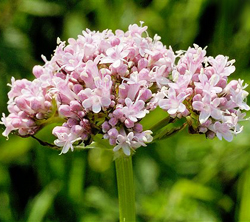 The valerian (Valeriana officinalis) is one of the most efficient healing herbs with sedative effect. Its name comes from Latin word “valere” that signifies “welfare”. In the traditional way the valerian root is used as natural sedative that determines an efficient action of relaxation at the level of the whole nervous central system. Carefully studied by the researchers even from the beginning of the XXth century, the valerian root contains over 150 compounds. Among these, an important place has the gamma-aminobutiric acid, aminoacid that is considered to be an important inhibitory of the neurotransmitters and which is found in almost 40% of the brain synapses. The numerous clinical studies have shown that this natural compound, that is present in the valerian root, determines the improving of the memory and of the cognitive functions and makes to disappear the tiredness or the weakness associated to the states of anxiety, nervousness or stress. Besides, the gamma-aminoburitic acid contained in the valerian root has at the same time an important nutritional value. This is why the use of the natural remedies that contain valerian makes possible the regeneration of the nervous system’s functions and the settlement of a profound state of relaxation that facilitates at the same time the installation of a restful sleep. As the numerous researches and clinical studies have shown on the valerian root, a remarkable fact must be remembered and that is even in the case of a repeated administration, on long periods of time, of the valerian root, it has absolutely no negative impact on the state of vigilance or on the response speed to nervous stimuli, processes that take place normally in the state of wakefulness.
The valerian (Valeriana officinalis) is one of the most efficient healing herbs with sedative effect. Its name comes from Latin word “valere” that signifies “welfare”. In the traditional way the valerian root is used as natural sedative that determines an efficient action of relaxation at the level of the whole nervous central system. Carefully studied by the researchers even from the beginning of the XXth century, the valerian root contains over 150 compounds. Among these, an important place has the gamma-aminobutiric acid, aminoacid that is considered to be an important inhibitory of the neurotransmitters and which is found in almost 40% of the brain synapses. The numerous clinical studies have shown that this natural compound, that is present in the valerian root, determines the improving of the memory and of the cognitive functions and makes to disappear the tiredness or the weakness associated to the states of anxiety, nervousness or stress. Besides, the gamma-aminoburitic acid contained in the valerian root has at the same time an important nutritional value. This is why the use of the natural remedies that contain valerian makes possible the regeneration of the nervous system’s functions and the settlement of a profound state of relaxation that facilitates at the same time the installation of a restful sleep. As the numerous researches and clinical studies have shown on the valerian root, a remarkable fact must be remembered and that is even in the case of a repeated administration, on long periods of time, of the valerian root, it has absolutely no negative impact on the state of vigilance or on the response speed to nervous stimuli, processes that take place normally in the state of wakefulness.
The sage
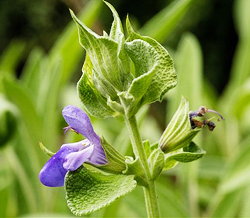 It is said that when you plant and then carefully take care of the sage in the garden, it will offer you then the gift of a long and happy life. In the antiquity, the sage (Salvia officinalis) was considered to be the herb that helps the old people enjoy life, like the young ones. Even from those times, the sage leaves were used in numerous natural preparations for the improving of the memory. In Latin language its name means “to heal”, just because of the fact that the sage leaves present healing properties in almost all the types of illnesses, reason for which it was considered a real panacea. The sage is part of the aromatic herbs. Beside the eucalyptol, the sage leaves contain also other substances with a strong antioxidant role. Comparative phisiochemical studies have shown that the sage has antioxidant effects almost as powerful as the different varieties of thyme. The sage leaves can be used in multiple manners both fresh and as dry powder. Chewed whole, be they fresh or dry, the sage leaves can rapidly generate a state of psychic energisation, casting away amazingly fast the states of anxiety, restlessness, fear or depression. Used systematically by those who know it, the sage can lead shortly to the improving of the attention and of vigilance. It encourages at the same time the refinement of the sensory perceptions and may fully contribute to the amplification of the benefic creative intelligence.
It is said that when you plant and then carefully take care of the sage in the garden, it will offer you then the gift of a long and happy life. In the antiquity, the sage (Salvia officinalis) was considered to be the herb that helps the old people enjoy life, like the young ones. Even from those times, the sage leaves were used in numerous natural preparations for the improving of the memory. In Latin language its name means “to heal”, just because of the fact that the sage leaves present healing properties in almost all the types of illnesses, reason for which it was considered a real panacea. The sage is part of the aromatic herbs. Beside the eucalyptol, the sage leaves contain also other substances with a strong antioxidant role. Comparative phisiochemical studies have shown that the sage has antioxidant effects almost as powerful as the different varieties of thyme. The sage leaves can be used in multiple manners both fresh and as dry powder. Chewed whole, be they fresh or dry, the sage leaves can rapidly generate a state of psychic energisation, casting away amazingly fast the states of anxiety, restlessness, fear or depression. Used systematically by those who know it, the sage can lead shortly to the improving of the attention and of vigilance. It encourages at the same time the refinement of the sensory perceptions and may fully contribute to the amplification of the benefic creative intelligence.
The cardamom
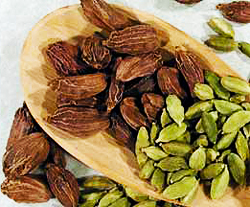 The cardamom (Elettaria cardamomum) is a plant that comes from the south of India. Brought from the Orient for its extremely flavoured taste and for its antitoxic properties, the cardamom comes to be used in Europe also to the flavouring of the coffee, due to the fact that neutralizes, in a certain measure, the harmful effect of the caffeine. The Arabs, good connoisseurs of the herb’s powers, are the ones who called it “the seed of love”. The cardamom is appreciated as aphrodisiac, reawakening not only the sexual appetite, but especially “the inner fire of love”. An extremely simple and efficient preparation in case of physical or nervous tiredness or lack of sexual appetite is obtained by mixing a fresh egg yolk with a little spoon of honey and a tip of grinded cardamom seeds. An extremely delicious and nourishing desert is the integral rise with milk and honey spiced with cardamom, coriander, ginger, and saffron and of course with cardamom seeds, all these in equal quantities. The cardamom seeds are also used to the preparation of the cakes, to which they confer an exquisite flavor.
The cardamom (Elettaria cardamomum) is a plant that comes from the south of India. Brought from the Orient for its extremely flavoured taste and for its antitoxic properties, the cardamom comes to be used in Europe also to the flavouring of the coffee, due to the fact that neutralizes, in a certain measure, the harmful effect of the caffeine. The Arabs, good connoisseurs of the herb’s powers, are the ones who called it “the seed of love”. The cardamom is appreciated as aphrodisiac, reawakening not only the sexual appetite, but especially “the inner fire of love”. An extremely simple and efficient preparation in case of physical or nervous tiredness or lack of sexual appetite is obtained by mixing a fresh egg yolk with a little spoon of honey and a tip of grinded cardamom seeds. An extremely delicious and nourishing desert is the integral rise with milk and honey spiced with cardamom, coriander, ginger, and saffron and of course with cardamom seeds, all these in equal quantities. The cardamom seeds are also used to the preparation of the cakes, to which they confer an exquisite flavor.
The basil
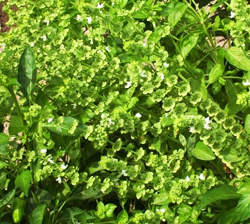 From the herbs used to healing purpose, the basil (Ocimum basilicum) is the herb that is known and appreciated currently almost in the whole world. Even from the time of ancient Greeks, the basil was significantly named “the king of the curative herbs”, the Greek term “basileus” having exactly the meaning of “king”. The basil comes from India, its cultivation spreading even from antiquity in the south of Europe. Having an extremely pleasant and refined flavour, the basil was and continues to be used to the flavouring of different dishes, among others also because of its digestive properties. The volatile oil present in its leaves contains linalol, eugenol and anetol. The basil is unanimously appreciated as an herb that can encourage the spiritual awakening. The specific flavour of the basil generates in the immediate ambiance an ineffable state of sacredness, producing this way, in the being of those who let themselves penetrated by its pleasant scent, a spontaneous orientation of the mind towards the good and luminous thoughts. The constant use of the dry powder from basil leaves is extremely benefic for those who seek to awake in their inner universe a state of harmony between the heart and the mind.
From the herbs used to healing purpose, the basil (Ocimum basilicum) is the herb that is known and appreciated currently almost in the whole world. Even from the time of ancient Greeks, the basil was significantly named “the king of the curative herbs”, the Greek term “basileus” having exactly the meaning of “king”. The basil comes from India, its cultivation spreading even from antiquity in the south of Europe. Having an extremely pleasant and refined flavour, the basil was and continues to be used to the flavouring of different dishes, among others also because of its digestive properties. The volatile oil present in its leaves contains linalol, eugenol and anetol. The basil is unanimously appreciated as an herb that can encourage the spiritual awakening. The specific flavour of the basil generates in the immediate ambiance an ineffable state of sacredness, producing this way, in the being of those who let themselves penetrated by its pleasant scent, a spontaneous orientation of the mind towards the good and luminous thoughts. The constant use of the dry powder from basil leaves is extremely benefic for those who seek to awake in their inner universe a state of harmony between the heart and the mind.
The foeniculum
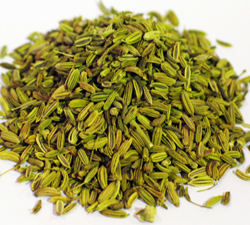 The foeniculum (Foeniculum vulgare) is appreciated to be an excellent fortifier, even from the time of ancient Greece. The foeniculum can successfully replace any other exotic herb, being a very strong stimulant for the digestion and generally for the organism’s functions. The foeniculum is often considered to be a food that is at the same time a valuable natural remedy too. The foeniculum seeds represent a very good aromatizer for the sweets. Together with the aniseeds and of the cinnamon one can obtain a extremely tasty flavoured combination for the sweet preparations, for cakes or for fruit salads. The sweet milk with foeniculum seeds is an excellent remedy for the irritable, quarrelsome, nervous or anxious persons. The recipe of preparation is the following: in a glass of hot sweet milk is added a little spoon of fine grinded powder of foeniculum seeds, then it’s let to cool off. It is drunk immediately with small swallowings. The powder of foeniculum seeds, administered separately, generates rapidly a state of psycho-mental energisation, increasing this way the vigilance and determining the settlement of a good humour state.
The foeniculum (Foeniculum vulgare) is appreciated to be an excellent fortifier, even from the time of ancient Greece. The foeniculum can successfully replace any other exotic herb, being a very strong stimulant for the digestion and generally for the organism’s functions. The foeniculum is often considered to be a food that is at the same time a valuable natural remedy too. The foeniculum seeds represent a very good aromatizer for the sweets. Together with the aniseeds and of the cinnamon one can obtain a extremely tasty flavoured combination for the sweet preparations, for cakes or for fruit salads. The sweet milk with foeniculum seeds is an excellent remedy for the irritable, quarrelsome, nervous or anxious persons. The recipe of preparation is the following: in a glass of hot sweet milk is added a little spoon of fine grinded powder of foeniculum seeds, then it’s let to cool off. It is drunk immediately with small swallowings. The powder of foeniculum seeds, administered separately, generates rapidly a state of psycho-mental energisation, increasing this way the vigilance and determining the settlement of a good humour state.
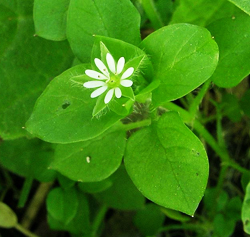
The chickweed
Present in wide areas from Asia and Europe, the chickweed (Stellaria media) is relatively common, but less known and appreciated in rapport with its wide spreading. The modern scientific researches have shown that the herb contains triptofane, beside the lavonoids, cumarines, saponines, mucilages, triterpenoids, sicilium, vitamin A and vitamin C. Emollient, fine and with a pleasant taste, the chickweed generates sedative effects on the psychic and on the mind. It contributes to a much better psychic and mental relaxation, confers state of calmness and helps the installation of a profound interiorization state, characterized by much enhanced lucidity.
SRINGATAKA
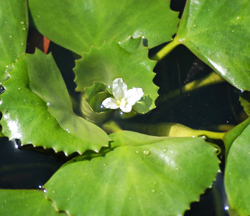 Sringataka (Trapa natans) or the “water chestnut” is known in the ayurvedic tradition as being one of the most important herbs with revitalizing virtues. In India, in the rural environment, the Sringataka fruits powder was used as a substitute of cereal flour, especially by those who followed certain diets with purifying role. In the Hindu communities, the flour of Sringataka fruits was included in the fast before the religious holidays, for the preparation of small cakes or small breads, slightly roasted. The plant is rich in mineral elements, especially calcium (20 mg per 100g).In the Yoga practice, the powder of Sringataka fruits is used for the amplification of the vitality state and for the stabilization of the mind fluctuations. The use of Sringataka fruits powder confers a profound stabilization of the mind and it allows the entrance in a superior state of contemplation. The state of “immobility” of the mind that results from the use of Sringataka fruit powder makes that the plant be useful to those who intend to improve in the accomplishment of the yogic technique LAYA YOGA. The constant use of this vitalizing plant create the premises of an expanded dynamization at the level of ANANDA MAYA KOSHA, facilitating this way the access to a profound inner state of happiness.
Sringataka (Trapa natans) or the “water chestnut” is known in the ayurvedic tradition as being one of the most important herbs with revitalizing virtues. In India, in the rural environment, the Sringataka fruits powder was used as a substitute of cereal flour, especially by those who followed certain diets with purifying role. In the Hindu communities, the flour of Sringataka fruits was included in the fast before the religious holidays, for the preparation of small cakes or small breads, slightly roasted. The plant is rich in mineral elements, especially calcium (20 mg per 100g).In the Yoga practice, the powder of Sringataka fruits is used for the amplification of the vitality state and for the stabilization of the mind fluctuations. The use of Sringataka fruits powder confers a profound stabilization of the mind and it allows the entrance in a superior state of contemplation. The state of “immobility” of the mind that results from the use of Sringataka fruit powder makes that the plant be useful to those who intend to improve in the accomplishment of the yogic technique LAYA YOGA. The constant use of this vitalizing plant create the premises of an expanded dynamization at the level of ANANDA MAYA KOSHA, facilitating this way the access to a profound inner state of happiness.
The vervain
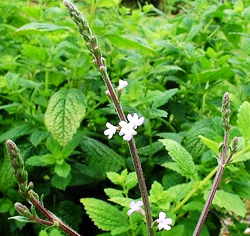 Known over 5000 years, the vervain (Verbena officinalis) is a healing herb used in different traditions of the world. During the ages, the vervain was appreciated as “the herb of love”. In the Middle Ages it was used for the preparation of some magic potions, that were able to tame the passionate nature of the warriors. The vervain is known and used also in the Indian tradition. In the Yunani medicine, the vervain is used as tonic, antifebrile, but especially as sedative, for the treatment of nervous disorders. In China, the vervain was used to treat the states of irritation, stress and nervous tension, because it was known for its profound calming and relaxing effect, that confers a very good state a psychic and mental level. What is remarkable in the vervain’s case is especially its special quality of shaping in a benefic way the roughness specific to the masculine nature that is not enough harmonized. The use of natural preparations from vervain or of the dry powder of this plant can lead to the appearance in the men’s being of an ample state of emotional openness towards the feminine nature.
Known over 5000 years, the vervain (Verbena officinalis) is a healing herb used in different traditions of the world. During the ages, the vervain was appreciated as “the herb of love”. In the Middle Ages it was used for the preparation of some magic potions, that were able to tame the passionate nature of the warriors. The vervain is known and used also in the Indian tradition. In the Yunani medicine, the vervain is used as tonic, antifebrile, but especially as sedative, for the treatment of nervous disorders. In China, the vervain was used to treat the states of irritation, stress and nervous tension, because it was known for its profound calming and relaxing effect, that confers a very good state a psychic and mental level. What is remarkable in the vervain’s case is especially its special quality of shaping in a benefic way the roughness specific to the masculine nature that is not enough harmonized. The use of natural preparations from vervain or of the dry powder of this plant can lead to the appearance in the men’s being of an ample state of emotional openness towards the feminine nature.
LAJJA
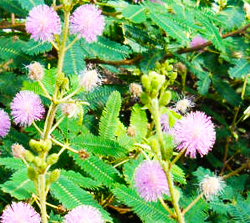 In the Orient, Lajja (Mimosa pudica) is a highly appreciated herb for the beauty of its flowers as well as for the sensibility that it has. Lajja is a plant sensible to touch. The Vedic tradition and the ayurvedic one mentions that this herb, if wisely used, can transfer its special property also in the subtle structure of the human being that uses it properly, amplifying this way the tactile sensibility and the refinement of the perception through touch. The modern laboratory researches have shown that Lajja contains calcium, mimosine, as well as some substances of the adrenalyne’s type, that all together can lead to an accentuation of the sensory receptivity in the case of the human being. In the ayurvedic tradition, the Lajja root is especially appreciated for its tonic aphrodisiac virtues. As aphrodisiac, the Lajja root increases the erotic sensibility and refinement. From a gustative point of view, it is extremely mucilaginous and sweet. Constantly used, for a certain period of time, the Lajja root helps very much to the increasing of inner coherence state and it also amplifies the state of harmony between the vital and the emotional sphere.
In the Orient, Lajja (Mimosa pudica) is a highly appreciated herb for the beauty of its flowers as well as for the sensibility that it has. Lajja is a plant sensible to touch. The Vedic tradition and the ayurvedic one mentions that this herb, if wisely used, can transfer its special property also in the subtle structure of the human being that uses it properly, amplifying this way the tactile sensibility and the refinement of the perception through touch. The modern laboratory researches have shown that Lajja contains calcium, mimosine, as well as some substances of the adrenalyne’s type, that all together can lead to an accentuation of the sensory receptivity in the case of the human being. In the ayurvedic tradition, the Lajja root is especially appreciated for its tonic aphrodisiac virtues. As aphrodisiac, the Lajja root increases the erotic sensibility and refinement. From a gustative point of view, it is extremely mucilaginous and sweet. Constantly used, for a certain period of time, the Lajja root helps very much to the increasing of inner coherence state and it also amplifies the state of harmony between the vital and the emotional sphere.
KUMARIKA
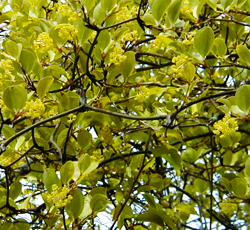 The name of the Indian herb Kumarika (Smilax chinensis) comes from the Sanskrit word “kumari” that means “young girl” or “virgin”. The name suggests the intense state of purity that the plant can generate in the human being that uses it properly. The herb is used not only in the ayurvedic tradition, but also in the entire east-Asiatic region. The Kumarika root is very much appreciated for its regenerating effects. In Ayurveda, the Kumarika root is characterized as having a prevalent sweet astringent taste. The herb contains saponines and flavonoids. These generate calming effects and lead to the harmonization of the psycho-emotional state of the being. The use of the dry powder from Kumarika root encourages the installation in the being of an intense state of calmness and of mind clarification. In the past the herb was frequently used by the yogis because it confers a much bigger ability to perceive distinctively the elevated subtle energies and eases at the same time the mental concentration, through the elimination of the parasite mental fluctuations. In the Yoga practice, the Kumarika root is very useful when the aspirant seeks to generate in his inner universe a disposition as favourable as possible for the accomplishment of deep meditations and of long duration.
The name of the Indian herb Kumarika (Smilax chinensis) comes from the Sanskrit word “kumari” that means “young girl” or “virgin”. The name suggests the intense state of purity that the plant can generate in the human being that uses it properly. The herb is used not only in the ayurvedic tradition, but also in the entire east-Asiatic region. The Kumarika root is very much appreciated for its regenerating effects. In Ayurveda, the Kumarika root is characterized as having a prevalent sweet astringent taste. The herb contains saponines and flavonoids. These generate calming effects and lead to the harmonization of the psycho-emotional state of the being. The use of the dry powder from Kumarika root encourages the installation in the being of an intense state of calmness and of mind clarification. In the past the herb was frequently used by the yogis because it confers a much bigger ability to perceive distinctively the elevated subtle energies and eases at the same time the mental concentration, through the elimination of the parasite mental fluctuations. In the Yoga practice, the Kumarika root is very useful when the aspirant seeks to generate in his inner universe a disposition as favourable as possible for the accomplishment of deep meditations and of long duration.
Article from The Book of the International Yoga Symposium, Costineşti 2009
yogaesoteric
Also available in:
 Română
Română
